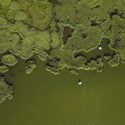Imagine if Earth suddenly lost an entire continent. North America wouldn’t just vanish off the face of the planet, of course. Instead, it would sink into the oceans.
What could cause this chain of unfortunate events? How long would it take for the continent to go down? How would this change the rest of the world?
One billion years ago, the continents meshed together into one supercontinent called Rodinia. But don’t mistake it for Pangea, that came long after. During the era of Rodinia, the continental crust that forms continents was at its thickest. From that point on, it began to slowly erode and sink.
At this rate of erosion, some two billion years from now, the continents will be fully submerged once again. I’m not ready to wait that long. So what do you say we speed things up for North America a little?
Okay, how exactly would this work? Well, remember what I just said about Rodinia and continental crust thickness? That’s right. The continents are shrinking and sinking. In our scenario, it would just happen much faster to North America.
The half-billion people that live in North America would lose their homes. They’d have to move out to another continent. But since events were unfolding so fast, the airlines would be unable to cope with so many passengers.
A lot of people would be left behind and go down with the continent. And those who were lucky enough to flee would cause a refugee crisis worldwide. But that would be just the beginning.
You might know that continents don’t just float in the ocean. They sit on the layer of solid rock, known as the upper mantle. This upper mantle and the Earth’s outermost layer, the crust, are broken into tectonic plates. And North America just happens to sit on one of them.
If the continent was to submerge, it would have to do with the North American tectonic plate going down. And this is where the bad news would start. The sinking of one tectonic plate would shift other plates around. This would trigger anything from tsunamis and earthquakes to volcanic eruptions. They might be massive enough to wipe out humanity altogether.
At the same time, the sea level would rise significantly. This would flood other areas of the world, displacing even more people and destroying more communities. It wouldn’t help that parts of North America are covered with ice. All that ice would float and then melt, adding to the effects of climate change.
If you were still alive, you’d have to invest in some powerful air conditioning because it would get very hot very quickly. The countless volcanic eruptions and other natural disasters unleashed by North America’s bold move would make it tough to continue farming. So I hope you like canned food.
Sources
- “Without Hot Rock, Much Of North America Would Be Underwater”. 2020. Sciencedaily.
- “These 11 sinking cities could disappear by 2100”. Talia Lakritz. 2020. World Economic Forum.
- “Study Finds East Coast Of America Is Sinking Into The Atlantic Ocean”. Nace, Trevor. 2020. Forbes.
- “Population Of Northern America (2020) – Worldometer”. 2020. worldometers.info.
- “Earth’s shrinking crust could leave us living on a water world”. Sokol, Joshua. 2020. New Scientist.
- “What keeps the continents floating on a sea of molten rock?”. 2020. Science Questions With Surprising Answers.



























